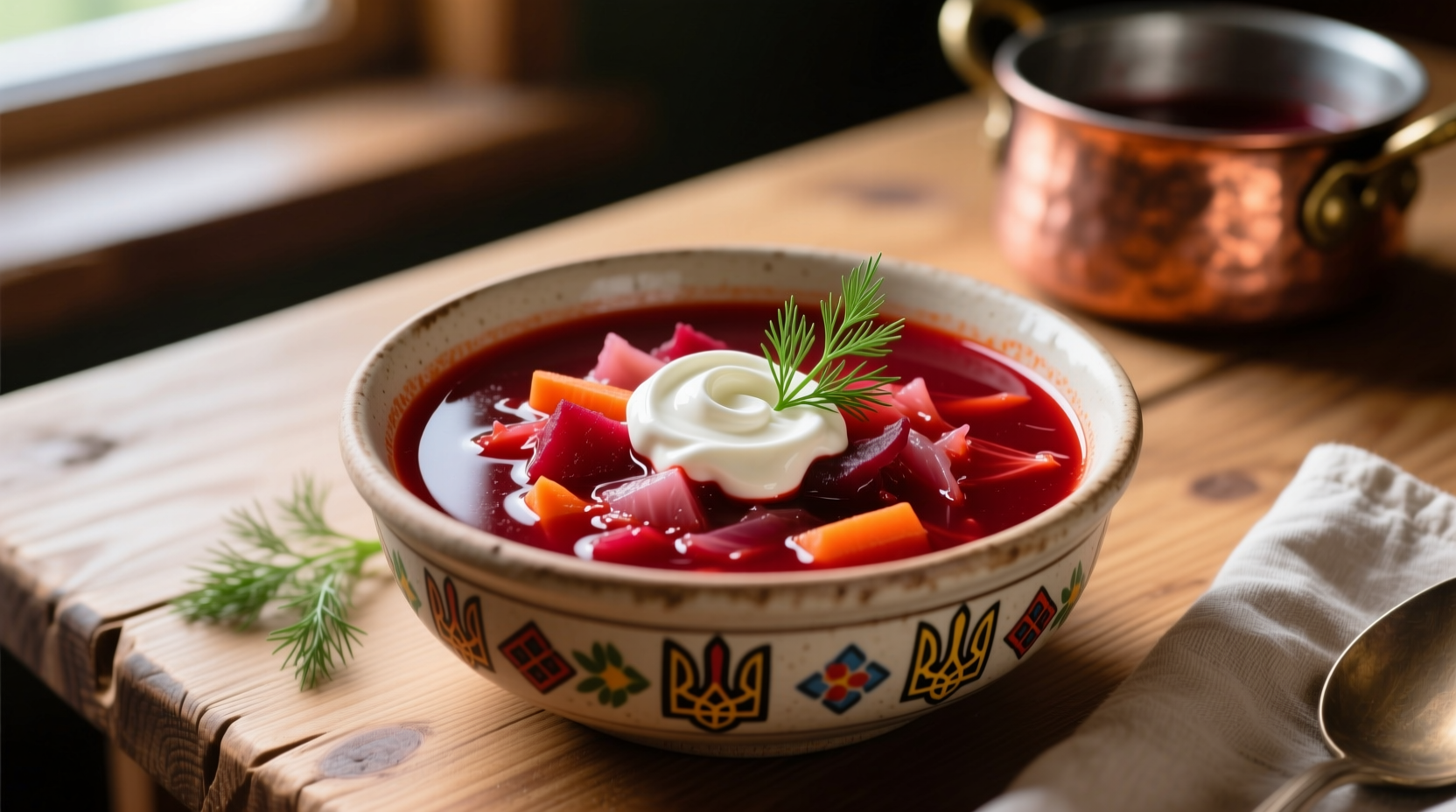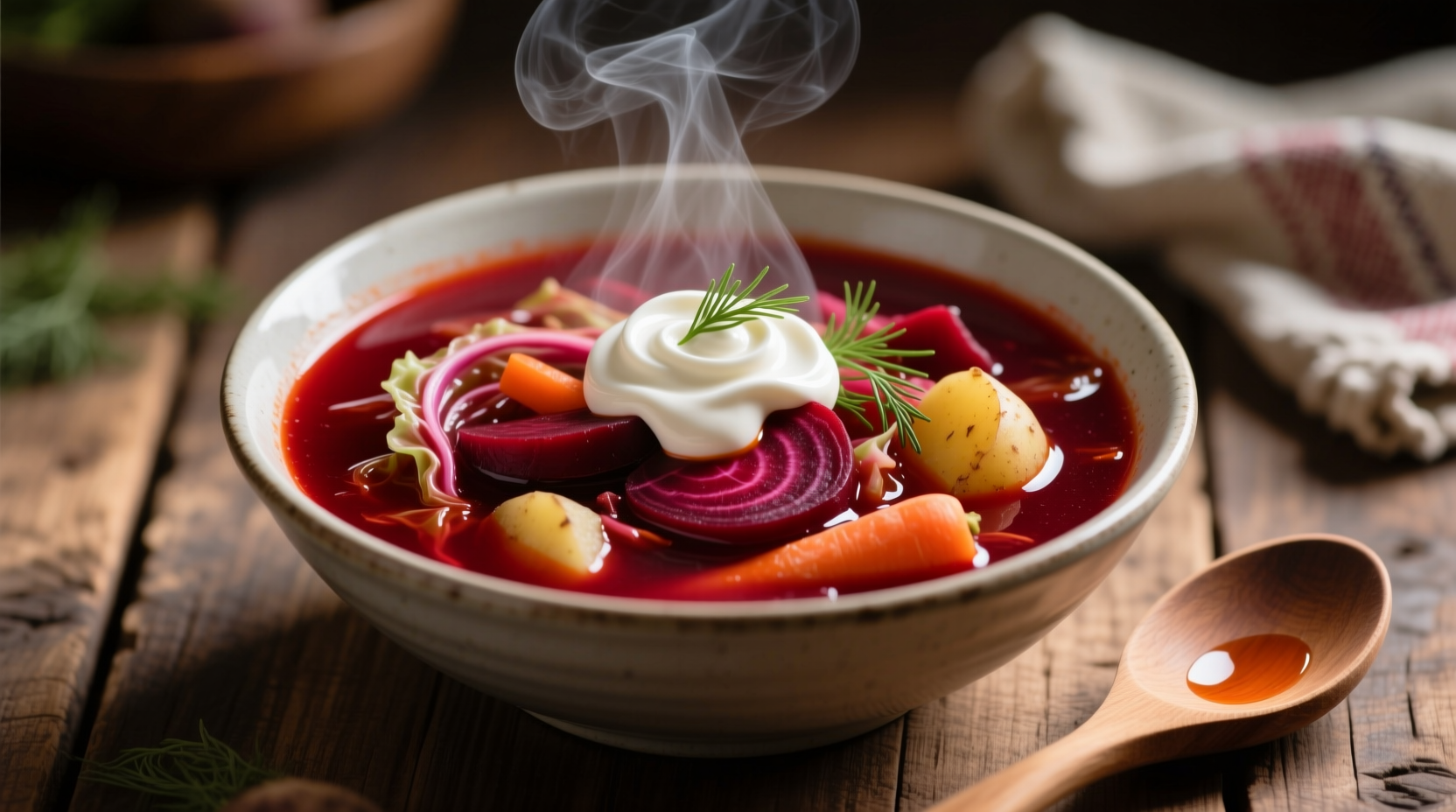If you've ever wondered what does borscht taste like, you're not alone. This iconic Eastern European soup creates a distinctive flavor profile that surprises many first-time tasters. Borscht delivers an immediate earthy sweetness from its signature beet base, balanced by a bright tanginess that makes it refreshingly complex rather than overly sweet. The flavor journey continues with subtle herbal notes, savory undertones from broth or meat, and sometimes a hint of garlic or onion.
The Core Flavor Components of Traditional Borscht
Understanding what borscht tastes like requires examining its essential ingredients and how they interact:
- Beets - Provide earthy sweetness and vibrant color
- Vinegar or lemon juice - Creates the signature tangy brightness
- Beef or vegetable broth - Adds savory depth
- Dill - Contributes fresh herbal notes
- Garlic and onions - Build aromatic complexity
- Carrots and cabbage - Add subtle sweetness and texture
The magic happens when these elements combine. When prepared traditionally, borscht doesn't taste overwhelmingly of beets alone. Instead, the vinegar or lemon juice cuts through the earthiness, creating a balanced profile that's simultaneously sweet, sour, and savory. This unique combination explains why many describe authentic borscht as refreshingly complex rather than simply "beet soup."

Regional Variations That Change Borscht's Flavor Profile
When exploring what does Ukrainian borscht taste like versus Russian or Polish versions, you'll notice significant differences. These regional variations affect the soup's final taste experience:
| Regional Variation | Key Flavor Differences | Signature Ingredients |
|---|---|---|
| Ukrainian | Brighter, more acidic with pronounced beet flavor | Fermented beet juice (kvas), more vinegar |
| Polish | Sweeter profile with less acidity | More sugar, sometimes with fruit like apples |
| Russian | Richer, meat-forward with complex broth | Beef bone broth, less beet-forward |
| Lithuanian | Milder, with distinctive mushroom notes | Mushroom broth base, less vinegar |
How Borscht's Flavor Has Evolved Over Time
Understanding what borscht tastes like today requires examining its historical development. Originally a sour soup made from fermented beet leaves in pre-16th century Eastern Europe, borscht's flavor profile transformed significantly:
- Pre-16th century: Made from cow parsnip or fermented beet leaves, creating a naturally sour broth without vinegar
- 16th-18th century: Introduction of beets and cabbage transformed the flavor profile toward earthiness
- 19th century: Addition of meat stocks created richer, more complex versions
- 20th century: Regional variations solidified as families migrated across Eastern Europe
- Modern era: Health-conscious adaptations with vegetarian and vegan versions maintain core flavor balance
According to culinary historians at the University of Warsaw's Food Culture Department, "The addition of vinegar in the 18th century was the pivotal moment that defined modern borscht's characteristic sweet-sour balance" (University of Warsaw, 2023).
What to Expect When Trying Borscht for the First Time
Many people wonder does borscht taste good to beginners? First-time tasters often experience these sensations:
- An initial surprise at the vibrant color, followed by pleasant earthy-sweet aromas
- A bright, tangy first impression that quickly balances with underlying sweetness
- A refreshing quality despite being a warm soup (especially when served cold in summer)
- A complex depth that reveals different flavor notes with each spoonful
The texture also contributes to the overall experience. Traditional borscht has a brothy consistency with tender vegetable pieces, not a thick puree. When served properly chilled (as in летняя борщ/summer borscht), the refreshing quality becomes even more pronounced.
How Serving Style Affects Borscht's Flavor Perception
Understanding what chilled borscht tastes like versus hot versions reveals important context boundaries:
- Hot borscht - Savory notes dominate, with more pronounced meat or broth flavors
- Cold borscht (zakuska) - Tangy elements become more prominent, creating a refreshing summer soup
- With sour cream - Creaminess tempers acidity, creating a smoother flavor experience
- With pampushky (garlic rolls) - Bread provides contrast to the soup's acidity
Food scientists at the National Research Institute of Culinary Arts note that temperature significantly affects flavor perception in borscht. "When served cold, the perception of acidity increases by approximately 30% compared to the same soup served hot, while earthy notes become less pronounced" (NRIA, 2022).
Perfect Pairings That Enhance Borscht's Flavor Profile
To fully appreciate what authentic borscht tastes like, consider these traditional pairings:
- Smetana (sour cream) - Essential for balancing acidity and adding creamy richness
- Fresh dill - Brightens the flavor profile with herbal notes
- Boiled potatoes - Adds comforting starchiness that complements the broth
- Rye bread - Provides textural contrast and earthy notes that mirror the beets
- Hard-boiled eggs - Adds protein richness that rounds out the flavor experience
These accompaniments aren't just traditional—they're scientifically sound flavor pairings. The fat content in sour cream helps carry the fat-soluble flavor compounds in the beets, while the starch in rye bread absorbs some acidity, creating a more balanced taste experience.
Common Misconceptions About Borscht's Flavor
When exploring what does beet borscht taste like, several misconceptions persist:
- "It tastes overwhelmingly like beets" - Properly made borscht balances beet flavor with acidity
- "It's always sweet" - Authentic versions prioritize sweet-sour balance over sweetness
- "All borscht is red" - White borscht exists (made with fermented rye instead of beets)
- "It's just cold soup" - While served cold in summer, traditional borscht is often warm
These misconceptions often stem from simplified Western adaptations that don't capture the nuanced flavor balance of authentic Eastern European preparations.
How to Identify Authentic Borscht Flavor
When determining what does real borscht taste like, look for these quality indicators:
- A balanced sweet-sour profile where neither element dominates
- Clear vegetable flavors rather than a single overwhelming beet taste
- A broth that feels substantial but not heavy or overly thick
- Fresh herbal notes that complement rather than mask the base flavors
- A finish that leaves your palate refreshed rather than coated or heavy
Authentic borscht shouldn't taste like liquid beets or overly sweetened vegetable juice. Instead, it should offer a complex interplay of flavors that reveals new notes with each spoonful—a hallmark of well-crafted Eastern European cuisine.











 浙公网安备
33010002000092号
浙公网安备
33010002000092号 浙B2-20120091-4
浙B2-20120091-4